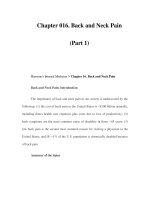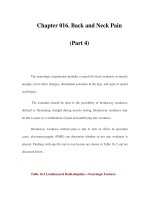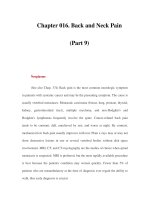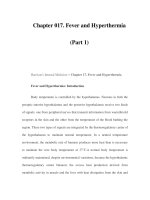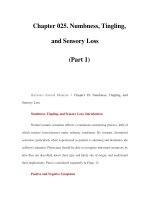Chapter 070. Nutritional Requirements and Dietary Assessment (Part 1) docx
Bạn đang xem bản rút gọn của tài liệu. Xem và tải ngay bản đầy đủ của tài liệu tại đây (13.4 KB, 5 trang )
Chapter 070. Nutritional Requirements
and Dietary Assessment
(Part 1)
Harrison's Internal Medicine > Chapter 70. Nutritional Requirements and
Dietary Assessment
Nutritional Requirements and Dietary Assessment: Introduction
Nutrients are substances that must be supplied by the diet because they are
not synthesized in the body in sufficient amounts. Nutrient requirements for
groups of healthy persons have been determined experimentally. For good health
we require energy-providing nutrients (protein, fat, and carbohydrate), vitamins,
minerals, and water. Specific nutrient requirements include 9 essential amino
acids, several fatty acids, 4 fat-soluble vitamins, 10 water-soluble vitamins, and
choline. Several inorganic substances, including 4 minerals, 7 trace minerals, 3
electrolytes, and the ultratrace elements, also must be supplied in the diet.
The required amounts of the essential nutrients differ by age and
physiologic state. Conditionally essential nutrients are not required in the diet but
must be supplied to individuals who do not synthesize them in adequate amounts,
such as those with genetic defects, those having pathologic states with nutritional
implications, and developmentally immature infants. Many organic
phytochemicals and zoochemicals present in foods have health effects. For
example, dietary fiber has beneficial effects on gastrointestinal function. Other
bioactive food constituents or contaminants such as lead may have negative health
effects.
Essential Nutrient Requirements
Energy
For weight to remain stable, energy intake must match energy output. The
major components of energy output are resting energy expenditure (REE) and
physical activity; minor sources include the energy cost of metabolizing food
(thermic effect of food or specific dynamic action) and shivering thermogenesis
(e.g., cold-induced thermogenesis). The average energy intake is about 2800
kcal/d for American men and about 1800 kcal/d for American women, although
these estimates vary with body size and activity level. Formulas for estimating
REE are useful for assessing the energy needs of an individual whose weight is
stable. Thus, for males, REE = 900 + 10w, and for females, REE = 700 + 7w,
where w is weight in kilograms. The calculated REE is then adjusted for physical
activity level by multiplying by 1.2 for sedentary, 1.4 for moderately active, or 1.8
for very active individuals. The final figure provides a rough estimate of total
caloric needs in a state of energy balance. Formulas to provide more precise
estimates of energy requirements are provided by the Food and Nutrition Board,
Institute of Medicine, National Academy of Sciences in recent reports on dietary
reference intakes. For further discussion of energy balance in health and disease,
see Chap. 72.
Protein
Dietary protein consists of both essential and other amino acids that are
required for protein synthesis. The nine essential amino acids are histidine,
isoleucine, leucine, lysine, methionine/cystine, phenylalanine/tyrosine, threonine,
tryptophan, and valine. All amino acids can be used for energy, and certain amino
acids (e.g., alanine) can also be used for gluconeogenesis. When energy intake is
inadequate, protein intake must be increased, since ingested amino acids are
diverted into pathways of glucose synthesis and oxidation. In extreme energy
deprivation, protein-calorie malnutrition may ensue (Chap. 72).
For adults, the recommended dietary allowance (RDA) for protein is about
0.6 g/kg desirable body weight per day, assuming that energy needs are met and
that the protein is of relatively high biologic value. Current recommendations for a
healthy diet call for at least 10–14% of calories from protein. Biologic value tends
to be highest for animal proteins, followed by proteins from legumes (beans),
cereals (rice, wheat, corn), and roots. Combinations of plant proteins that
complement one another in biologic value or combinations of animal and plant
proteins can increase biologic value and lower total protein requirements.
Protein needs increase during growth, pregnancy, lactation, and
rehabilitation after malnutrition. Tolerance to normal amounts of dietary protein is
decreased in renal insufficiency and liver failure, precipitating encephalopathy in
patients with cirrhosis of the liver.
Fat and Carbohydrate
Fats are a concentrated source of energy and constitute on average 34% of
calories in U.S. diets. For optimal health, saturated fat and trans-fat should be
limited to <10% of calories, and polyunsaturated fats to <10% of calories, with
monounsaturated fats constituting the remainder of fat intake. At least 55% of total
calories should be derived from carbohydrates. The brain requires about 100 g/d of
glucose for fuel; other tissues use about 50 g/d. Some tissues (e.g., brain and red
blood cells) rely on glucose supplied either exogenously or from muscle
proteolysis. Over time, some adaptations in carbohydrate needs are possible in
other tissues during hypocaloric states (Chap. 339).




